"Don't talk to me about naval tradition. It's nothing but rum, sodomy, and the lash."
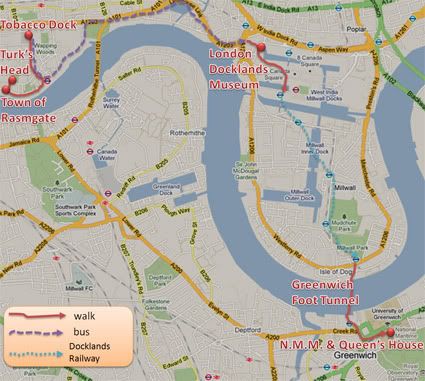
Wapping
 The rendez-vous was 10:00 for breakfast at the Turk's Head, now a cafe for local families, but not long ago a pub bristling with history just like every pub around there. Take the name for example. It refers to one of the most intricate maritime knots. Used decoratively more often than practically, the knot took the name because of its resemblance to a turban.
The rendez-vous was 10:00 for breakfast at the Turk's Head, now a cafe for local families, but not long ago a pub bristling with history just like every pub around there. Take the name for example. It refers to one of the most intricate maritime knots. Used decoratively more often than practically, the knot took the name because of its resemblance to a turban.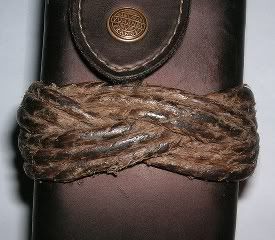 The pub itself is said to have been the only pub licensed to sell the last quart of ale to pirates on their way from Newgate to the Execution dock where they would be hanged. In World War 2, run by its eccentric landlady, Turk's head stayed open all hours for service personnel seeking news of their loved ones. Today, it's a charity; the income from the rents of the cafe and studios above pays for local charitable activities.
The pub itself is said to have been the only pub licensed to sell the last quart of ale to pirates on their way from Newgate to the Execution dock where they would be hanged. In World War 2, run by its eccentric landlady, Turk's head stayed open all hours for service personnel seeking news of their loved ones. Today, it's a charity; the income from the rents of the cafe and studios above pays for local charitable activities.One minute away, the Town of Ramsgate is a long narrow pub next to a tiny but delightfully historic alleyway known as Wapping Old Stairs. The stairs lead down to the riverside
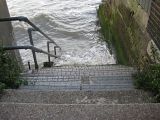 where fishermen from Ramsgate sold their catch. It was on Wapping Old Stairs, in 1688, that Judge Jeffreys (the Hanging Judge) was captured while trying to flee the country dressed as a sailor. During the War of the English Succession, when King James II left for France, Jeffreys stayed in London till the last moment, being the only high legal authority in the abandoned kingdom. When the armies of William were approaching London, Jeffreys attempted to flee the country too. He was captured outside the pub that is now known as The Town of Ramsgate. Jeffreys was disguised as a sailor, but was
where fishermen from Ramsgate sold their catch. It was on Wapping Old Stairs, in 1688, that Judge Jeffreys (the Hanging Judge) was captured while trying to flee the country dressed as a sailor. During the War of the English Succession, when King James II left for France, Jeffreys stayed in London till the last moment, being the only high legal authority in the abandoned kingdom. When the armies of William were approaching London, Jeffreys attempted to flee the country too. He was captured outside the pub that is now known as The Town of Ramsgate. Jeffreys was disguised as a sailor, but was 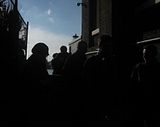 recognised by a surviving judicial victim and was captured. You can imagine him running furiously in the narrow alleys trying to escape the mob and ending up to the dead-end of the Wapping Old Stairs. He begged his captors for protection from the mob and was placed in custody in the Tower of London, where he died of kidney disease a little later; the disease was painful and may have contributed to his bad temper while a judge. Jeffreys's legal ability was undoubtedly high, but he was a vengeful man. He had bitter personal and professional rivalries with Sir William Williams, whom he tried to ruin.
recognised by a surviving judicial victim and was captured. You can imagine him running furiously in the narrow alleys trying to escape the mob and ending up to the dead-end of the Wapping Old Stairs. He begged his captors for protection from the mob and was placed in custody in the Tower of London, where he died of kidney disease a little later; the disease was painful and may have contributed to his bad temper while a judge. Jeffreys's legal ability was undoubtedly high, but he was a vengeful man. He had bitter personal and professional rivalries with Sir William Williams, whom he tried to ruin.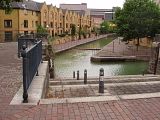 Nowadays a most dignified area, this part of London used to be lively, bustling, and brutal. Men press-ganged into naval service and convicts destined for transportation to Australia, were held in cellars at the pub. Execution Dock is just nearby. The condemned were hanged and then chained to posts in the river, the tide rising over them three times before their bodies were removed.
Nowadays a most dignified area, this part of London used to be lively, bustling, and brutal. Men press-ganged into naval service and convicts destined for transportation to Australia, were held in cellars at the pub. Execution Dock is just nearby. The condemned were hanged and then chained to posts in the river, the tide rising over them three times before their bodies were removed.One of them was Captain Kidd; either one of the most notorious pirates or the most unjustly prosecuted privateer. In 1689, at 44, he was member of a French-English pirate crew in the Caribbean. Kidd and other members of the crew mutinied and sailed to the English colony of Nevis. He became captain and helped the local governor to defend Nevis from the French. As the governor did not want to pay, he told them they could take their pay by looting the French. Various privateer actions followed until 1695 when the governor of New York asked the "trusty and well beloved Captain Kidd" to attack pirates and French ships. He gave Kidd a letter of Marque signed by King William III of England himself, which reserved 10% of the loot for the Crown. Kidd sold his ship to buy one more suitable for hunting pirates and he personally selected the crew. As they sailed down the Thames, not only they didn't salute a Navy yacht at Greenwich, but his crew turned and slapped their backsides in disdain. The Navy vessel's captain retaliated by pressing much of Kidd's crew into naval service. To make up for the lack of officers, Kidd had to pick up criminals and ex-pirates in New York. Acts of savagery were reported by escaped prisoners, who told stories of being hoisted up by the arms and drubbed with a drawn cutlass. On one occasion, crew members ransacked the trading ship, Mary and tortured several of its crew members while Kidd and the other captain conversed privately in Kidd's cabin. When Kidd found out, he was outraged and forced his men to return the stolen property. Kidd was declared a pirate very early in his voyage by a Royal Navy officer to whom he had promised "thirty men or so", but sailed away during the night to save his crew.
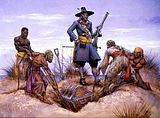 Fast-forward a few months... Realising that his ship was marked, he cached it in the Caribbean and continued aboard a sloop. He is alleged to have deposited some of his treasure on Gardiners Island, hoping to use knowledge of its location as a bargaining tool.
Fast-forward a few months... Realising that his ship was marked, he cached it in the Caribbean and continued aboard a sloop. He is alleged to have deposited some of his treasure on Gardiners Island, hoping to use knowledge of its location as a bargaining tool.He was eventually sent to England for questioning by Parliament. The new Tory ministry tried to use Kidd as a tool to discredit the Whigs who had backed him, but
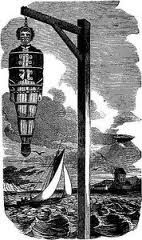 Kidd refused to reveal names, naïvely confident his patrons would reward his loyalty by interceding. Finding him politically useless, the Tories sent him to stand trial for piracy and the murder of one of his sailors. He was hanged on May 23, 1701, at Execution Dock. His body was left to hang in an iron cage over the river for twenty years as a warning to would-be pirates.
Kidd refused to reveal names, naïvely confident his patrons would reward his loyalty by interceding. Finding him politically useless, the Tories sent him to stand trial for piracy and the murder of one of his sailors. He was hanged on May 23, 1701, at Execution Dock. His body was left to hang in an iron cage over the river for twenty years as a warning to would-be pirates.His treasure was never found and even today there are treasure hunters looking for it in the Carribean, North America, Japan and Vietnam. Wikipedia mentions over 30 appearances of Captain Kidd in popular culture, from manga and poems to computer games, Sid Meier's Pirates being the most notable.
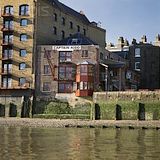 Back to our walk, as we reach the Captain Kidd pub, one of the coolest pubs in London. Too early to try the beers, but the building itself, a converted warehouse, is inspiring. Interestingly, nearby is River Thames Police, the first police force in history. It was set up in 1798 to tackle the widespread theft and looting from anchored ships.
Back to our walk, as we reach the Captain Kidd pub, one of the coolest pubs in London. Too early to try the beers, but the building itself, a converted warehouse, is inspiring. Interestingly, nearby is River Thames Police, the first police force in history. It was set up in 1798 to tackle the widespread theft and looting from anchored ships.We now head north, towards a most unusual, rather eerie place. If you haven't been
 to the Tobacco Dock before, a 19th century warehouse lavishly converted into a very modern shopping centre, you'll think it's nearing completion. It isn't. It has been completed for over 20 years. Everything is there. Even the necessary final quirky details to make sure that Tobacco Dock would be the new Covent Garden. Even two replica pirate ships to entertain the kids! How extravagant is that! But it all collapsed (all but the building), when the markets started falling again in the '90s and the East End appeared not to be such an up-and-coming place after all.
to the Tobacco Dock before, a 19th century warehouse lavishly converted into a very modern shopping centre, you'll think it's nearing completion. It isn't. It has been completed for over 20 years. Everything is there. Even the necessary final quirky details to make sure that Tobacco Dock would be the new Covent Garden. Even two replica pirate ships to entertain the kids! How extravagant is that! But it all collapsed (all but the building), when the markets started falling again in the '90s and the East End appeared not to be such an up-and-coming place after all. 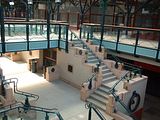 I made the mistake to try to open one of the doors instead of trying to find an entrance further down, and that activated the lovely 1990s automated security system "You are trespassing, you are trespassing ...". That woke the guard up, who felt obliged to get us out of there immediately. He must have gone mad taking orders from a crackling 90's loudspeaker for the last 20 years. Does he feel like a Charlie's angel?
I made the mistake to try to open one of the doors instead of trying to find an entrance further down, and that activated the lovely 1990s automated security system "You are trespassing, you are trespassing ...". That woke the guard up, who felt obliged to get us out of there immediately. He must have gone mad taking orders from a crackling 90's loudspeaker for the last 20 years. Does he feel like a Charlie's angel?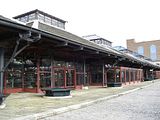
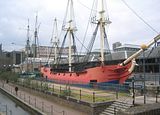
 Next stop, Canary Wharf, but on the way we pass through Poplar, the poorest area in London, which is in the shadow of Canary Wharf's scyscrapers. Literally.
Next stop, Canary Wharf, but on the way we pass through Poplar, the poorest area in London, which is in the shadow of Canary Wharf's scyscrapers. Literally.Canary Wharf
While Canary Wharf is the hard-beating financial heart of what's left of the British Empire, on a cold Sunday morning it's as dead as Tobacco Dock. I exaggerate, but that's what people do in Canary Wharf.
 We visited it for the Docklands Museum, which I have to admit, was a very pleasant surprise. Impeccably presented and quite innovative. My favourite part was the reproduction of dock alley in the early 18th century. Dark and smelly, it feels as if you are about to be ambushed by some scar-faced criminal or the navy's press gangs. Some find it cheesy like Disneyland. Maybe. I didn't care.
We visited it for the Docklands Museum, which I have to admit, was a very pleasant surprise. Impeccably presented and quite innovative. My favourite part was the reproduction of dock alley in the early 18th century. Dark and smelly, it feels as if you are about to be ambushed by some scar-faced criminal or the navy's press gangs. Some find it cheesy like Disneyland. Maybe. I didn't care.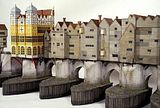 The model of the medieval London Bridge is also superb, with its houses and shops, the rental of which was paying for the bridge's costs. Like Florence, if I remember correctly.
The model of the medieval London Bridge is also superb, with its houses and shops, the rental of which was paying for the bridge's costs. Like Florence, if I remember correctly.By the way, among the many security precautions in Canary Wharf, the coolest is a Royal Navy destroyer. No, it doesn't aspire to hunt das boot. It's there to shoot down missiles.
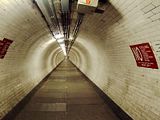 Right, enough with Canary Wharf. Let's move on to Greenwich... from underground, below the river Thames. If you are claustrophobic, have trouble breathing without fresh air supply and think that the water dripping from the ceiling is a sign that the tunnel will collapse and you'll drown, DON'T ENTER and take the docklands railway. But I am an insensitive bastard. I absolutely loved it. Not as much the poor sods following me.
Right, enough with Canary Wharf. Let's move on to Greenwich... from underground, below the river Thames. If you are claustrophobic, have trouble breathing without fresh air supply and think that the water dripping from the ceiling is a sign that the tunnel will collapse and you'll drown, DON'T ENTER and take the docklands railway. But I am an insensitive bastard. I absolutely loved it. Not as much the poor sods following me.Most people visit Greenwich to queue up for a picture in front of the Prime Meridian with one foot on the western and the other on the eastern hemisphere, presumably to place it next to the hold-the-tower-of-Pisa photo in the album of their cliché life. I visit Greenwich for the Queen's House; in my opinion, the most inspiring little gallery of maritime art. If it doesn't make you feel anything, then don't bother getting in the National Maritime Museum either, as the maritime theme isn't for you. If it is though, make sure you have a good four hours.

Queen's House
One of my favourite paintings in the Queen's House is "The Sinking of Scharnhorst"

On Christmas Day 1943, Admiral Doenitz signals Scharnhorst: "The enemy is attempting to aggravate the difficulties of our eastern land forces in their heroic struggle by sending an important convoy of provisions and arms to the Russians. We must help". The Scharnhorst sets sail, unaware that she is being lured into a Royal Navy trap with two convoys providing the bait. When the British ships opens fire, Scharnhorst is taken by surprise and a shell from HMS Norfolk destroys her radar. Now alone and blind, facing a total of 13 Allied warships, she tries to escape with her superior speed, but one of her boiler rooms takes a direct hit, slowing her dramatically. She signals: "To the Fuhrer. We shall fight to the last shell". On board HMS Duke of York, Admiral Fraser ceases firing and orders his combined forces to attack with torpedoes. In the meantime, Scharnorst hits the destroyer HMS Saumarez and 11 British seamen get killed. The British fire a total of 55 torpedoes against Scharnhorst and 11 find their target. The commander of Scharnhorst broadcasts to his crew: "I shake you all by the hand for the last time". Of a crew of 1,968 men only 36 will survive.

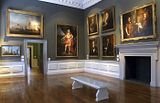
National Maritime Museum
The museum is probably the best of its kind globally. I'll only focus on my favourite exhibits.
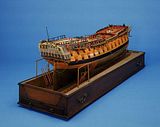 Ship models usually depict a historic ship. A few models go beyond that and become history themselves. Bellona was launched in 1760 but this model is from 1770. Notice the layer of copper below the waterline of the hull and the fitted handles. This is the model used to demonstrate copper sheathing to King George III. The King was convinced that this is the way to beat the French and ordered 50 (I think) warships to receive this upgrade immediately. Coppering prevented shipworm and weed and barnacles growing on the hull, which seriously affected sailing ability. With healthier hulls, British ships could operate away from dockyards for longer periods, sail faster and turn faster than their enemies. THAT's what we call disruptive technology.
Ship models usually depict a historic ship. A few models go beyond that and become history themselves. Bellona was launched in 1760 but this model is from 1770. Notice the layer of copper below the waterline of the hull and the fitted handles. This is the model used to demonstrate copper sheathing to King George III. The King was convinced that this is the way to beat the French and ordered 50 (I think) warships to receive this upgrade immediately. Coppering prevented shipworm and weed and barnacles growing on the hull, which seriously affected sailing ability. With healthier hulls, British ships could operate away from dockyards for longer periods, sail faster and turn faster than their enemies. THAT's what we call disruptive technology.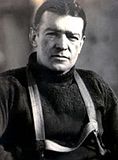 Out of the explorers of the early 20th century, my favourite is one of the least successful. Ernest Shackleton and his men set sail in 1914 to reach the South Pole. On 19 January 1915, his ship became locked in the ice of the Weddell Sea and over the next nine months it was gradually crushed, finally sinking in October. It proved impossible for his 28 men to drag their boats and stores across the frozen sea so Shackleton camped on the ice and drifted with it. When the ice began to break up as it drifted north into warmer waters,
Out of the explorers of the early 20th century, my favourite is one of the least successful. Ernest Shackleton and his men set sail in 1914 to reach the South Pole. On 19 January 1915, his ship became locked in the ice of the Weddell Sea and over the next nine months it was gradually crushed, finally sinking in October. It proved impossible for his 28 men to drag their boats and stores across the frozen sea so Shackleton camped on the ice and drifted with it. When the ice began to break up as it drifted north into warmer waters, 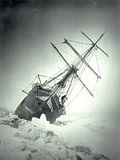 the men launched the three boats and in extremely dangerous conditions managed to reach Elephant Island. This rocky island was still very far from inhabited land. They were cold and exhausted. They knew they would not be found and that their supplies of food would not last long. There were seals and penguins to kill for food and fuel but not many and they eventually had to rely on collecting shellfish. Shackleton decided to leave most of the party behind, while he set out in a tiny boat to reach South Georgia, the nearest inhabited island, 800
the men launched the three boats and in extremely dangerous conditions managed to reach Elephant Island. This rocky island was still very far from inhabited land. They were cold and exhausted. They knew they would not be found and that their supplies of food would not last long. There were seals and penguins to kill for food and fuel but not many and they eventually had to rely on collecting shellfish. Shackleton decided to leave most of the party behind, while he set out in a tiny boat to reach South Georgia, the nearest inhabited island, 800  miles away. He knew that he would find help there, at the Norwegian whaling stations on the north side. He refused to pack supplies for more than four weeks, knowing that if they did not reach South Georgia within that time, the boat and its crew would be lost. In one of the most unlikely and heroic journeys in history, Shackleton reached the whaling station of Stromness, quickly organised the rescue mission and returned, eventually saving all his crew.
miles away. He knew that he would find help there, at the Norwegian whaling stations on the north side. He refused to pack supplies for more than four weeks, knowing that if they did not reach South Georgia within that time, the boat and its crew would be lost. In one of the most unlikely and heroic journeys in history, Shackleton reached the whaling station of Stromness, quickly organised the rescue mission and returned, eventually saving all his crew.I could go on for ever, but I'd better spend the time planning the next secret walk.
In the meantime, some more photos from the museum:
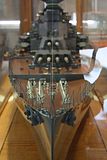
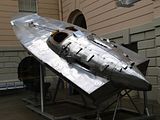

No comments:
Post a Comment